摘要
目前已有类似于QSGD和稀疏化SGD的通信优化算法,但参数服务器在实际应用中在收到工作节点量化梯度并聚合后,需要将聚合梯度从新分发给工作节点。本论文同时对工作节点和参数服务器梯度,采用误差补偿的方式进行梯度压缩。该算法有三大优势:
- 它兼容众多“粗暴”的压缩技术
- 它与没有误差补偿的压缩算法(例如QSGD和稀疏化SGD)相比,收敛性更好
- 达到了线性收敛
1 | if __name__ == "__main__": |
dfdfadf
背景介绍
提高分布式机器学习性能的三个方向:
(1)高通信效率的学习
- QSGD: Communication-efficient SGD via gradient quantization and encoding1(量化为三元组表示)
- signSGD: Compressed optimisation for non-convex problems2
- 1-bit stochastic gradient descent and its application to data-parallel distributed training of speech dnns3(提出一种误差补偿的量化方法)
(2)去中心化学习;
- He L, Bian A, Jaggi M. Cola: Decentralized linear learning[C]//Advances in Neural Information Processing Systems. 2018: 4536-4546.
- Lian X, Zhang C, Zhang H, et al. Can decentralized algorithms outperform centralized algorithms? a case study for decentralized parallel stochastic gradient descent[C]//Advances in Neural Information Processing Systems. 2017: 5330-5340.
(3)异步学习
- Agarwal A, Duchi J C. Distributed delayed stochastic optimization[C]//Advances in Neural Information Processing Systems. 2011: 873-881.
- Lian X, Huang Y, Li Y, et al. Asynchronous parallel stochastic gradient for nonconvex optimization[C]//Advances in Neural Information Processing Systems. 2015: 2737-2745.
- Recht B, Re C, Wright S, et al. Hogwild: A lock-free approach to parallelizing stochastic gradient descent[C]//Advances in neural information processing systems. 2011: 693-701.
量化压缩基本模型
作者对分布式机器学习(特别是参数服务器架构)和量化压缩数学模型简单做了介绍
分布式机器学习基本模型
\[ \min _{\boldsymbol{x}} f(\boldsymbol{x})=\frac{1}{n} \sum_{i=1}^{n} \mathbb{E}_{\boldsymbol{\zeta} \sim \mathcal{D}_{i}} F(\boldsymbol{x} ; \boldsymbol{\zeta}) \]
其中\(n\)表示工作节点数量,\(\mathcal{D}_{i}\)本地节点\(i\)的数据分布,\(F(\boldsymbol{x} ; \boldsymbol{\zeta})\)为本地损失函数。 \[ \boldsymbol{g}^{(i)}=\nabla F\left(\boldsymbol{x} ; \boldsymbol{\zeta}^{(i)}\right) \] 各工作节点计算梯度 \[ \boldsymbol{g}=\frac{1}{n} \sum_{i=1}^{n} \boldsymbol{g}^{(i)} \] 参数服务器对梯度进行聚合,以上是对分布式SGD算法的简单建模
量化压缩
\(Q_{\omega}[\cdot]\)代表压缩操作,以\(1Bits\)方法为例,利用递归的方法更新压缩误差: \[ \boldsymbol{\delta}^{(i)}=\boldsymbol{g}^{(i)}+\boldsymbol{\delta}^{(i)}-Q_{\omega}\left[\boldsymbol{g}^{(i)}+\boldsymbol{\delta}^{(i)}\right] \] 其中\(\left[\boldsymbol{g}^{(i)}+\boldsymbol{\delta}^{(i)}\right]\)表示本轮计算得到的梯度\(g^{(i)}\)和上一轮压缩误差\(\boldsymbol{\delta}^{(i)}\)的和,上式子是对本轮量化误差的重新计算,这也是误差补偿的由来。
主要贡献
- 比其他没有错误补偿的压缩方法具有更好的收敛性
- 进一步优化了通信效率
- 第一次给出了误差补偿SGD相关算法的速率分析
- 在非凸情况下的加速证明
相关工作
分布式学习
中心化并行训练
参数服务器架构
- Abadi M, Barham P, Chen J, et al. Tensorflow: A system for large-scale machine learning[C]//12th {USENIX} symposium on operating systems design and implementation ({OSDI} 16). 2016: 265-283.
- Li M, Andersen D G, Park J W, et al. Scaling distributed machine learning with the parameter server[C]//11th {USENIX} Symposium on Operating Systems Design and Implementation ({OSDI} 14). 2014: 583-598.
去中心化训练
- 固定拓扑
- Jin P H, Yuan Q, Iandola F, et al. How to scale distributed deep learning?[J]. arXiv preprint arXiv:1611.04581, 2016.
- Lian X, Zhang C, Zhang H, et al. Can decentralized algorithms outperform centralized algorithms? a case study for decentralized parallel stochastic gradient descent[C]//Advances in Neural Information Processing Systems. 2017: 5330-5340.
- Shen Z, Mokhtari A, Zhou T, et al. Towards more efficient stochastic decentralized learning: Faster convergence and sparse communication[J]. arXiv preprint arXiv:1805.09969, 2018.
- Tang H, Lian X, Yan M, et al. D \(^ 2\): Decentralized Training over Decentralized Data[J]. arXiv preprint arXiv:1803.07068, 2018.
- 随机拓扑
- Lian X, Zhang W, Zhang C, et al. Asynchronous decentralized parallel stochastic gradient descent[C]//International Conference on Machine Learning. 2018: 3043-3052.
- Nedić A, Olshevsky A. Distributed optimization over time-varying directed graphs[J]. IEEE Transactions on Automatic Control, 2014, 60(3): 601-615.
- Nedic A, Olshevsky A, Shi W. Achieving geometric convergence for distributed optimization over time-varying graphs[J]. SIAM Journal on Optimization, 2017, 27(4): 2597-2633.
不同角度实现分布式训练
- 隐私分布式优化
- Jayaraman B, Wang L, Evans D, et al. Distributed learning without distress: Privacy-preserving empirical risk minimization[C]//Advances in Neural Information Processing Systems. 2018: 6343-6354.
- 自适应分布式ADMM
- Xu Z, Taylor G, Li H, et al. Adaptive consensus ADMM for distributed optimization[J]. arXiv preprint arXiv:1706.02869, 2017.
- 非平滑分布式优化
- Scaman K, Bach F, Bubeck S, et al. Optimal algorithms for non-smooth distributed optimization in networks[C]//Advances in Neural Information Processing Systems. 2018: 2740-2749.
- 分布式近端原对称对偶算法
- Hong M, Hajinezhad D, Zhao M M. Prox-PDA: The proximal primal-dual algorithm for fast distributed nonconvex optimization and learning over networks[C]//International Conference on Machine Learning. 2017: 1529-1538.
- 投影-free的分布式在线学习
- Zhang W, Zhao P, Zhu W, et al. Projection-free distributed online learning in networks[C]//International Conference on Machine Learning. 2017: 4054-4062.
- 平行倒推
- Huo Z, Gu B, Yang Q, et al. Decoupled parallel backpropagation with convergence guarantee[J]. arXiv preprint arXiv:1804.10574, 2018.
压缩通信学习
稀疏化模型
- Wang J, Kolar M, Srebro N, et al. Efficient distributed learning with sparsity[C]//International Conference on Machine Learning. 2017: 3636-3645.
梯度量化
- Shen Z, Mokhtari A, Zhou T, et al. Towards more efficient stochastic decentralized learning: Faster convergence and sparse communication[J]. arXiv preprint arXiv:1805.09969, 2018.
QSGD
- Alistarh D, Grubic D, Li J, et al. QSGD: Communication-efficient SGD via gradient quantization and encoding[C]//Advances in Neural Information Processing Systems. 2017: 1709-1720.
PCA压缩
- Garber D, Shamir O, Srebro N. Communication-efficient algorithms for distributed stochastic principal component analysis[J]. arXiv preprint arXiv:1702.08169, 2017.
\(1Bits\)量化
- Seide F, Fu H, Droppo J, et al. 1-bit stochastic gradient descent and its application to data-parallel distributed training of speech dnns[C]//Fifteenth Annual Conference of the International Speech Communication Association. 2014.
- Wen W, Xu C, Yan F, et al. Terngrad: Ternary gradients to reduce communication in distributed deep learning[C]//Advances in neural information processing systems. 2017: 1509-1519.
错误补偿压缩
\(1Bits\)量化
- Seide F, Fu H, Droppo J, et al. 1-bit stochastic gradient descent and its application to data-parallel distributed training of speech dnns[C]//Fifteenth Annual Conference of the International Speech Communication Association. 2014.
二次优化
- Wu J, Huang W, Huang J, et al. Error compensated quantized SGD and its applications to large-scale distributed optimization[J]. arXiv preprint arXiv:1806.08054, 2018.
SignSGD
- Bernstein J, Wang Y X, Azizzadenesheli K, et al. signSGD: Compressed optimisation for non-convex problems[J]. arXiv preprint arXiv:1802.04434, 2018.
- Alistarh D, Hoefler T, Johansson M, et al. The convergence of sparsified gradient methods[C]//Advances in Neural Information Processing Systems. 2018: 5973-5983.
算法介绍
算法描述
本文采用参数服务器架构描述该算法,但是算法的应用场景不仅限于参数服务器架构,在第\(t\)次迭代,我们将该算法的关键步骤描述如下:
- 工作节点计算
每个节点\(i\)计算本地随机梯度\(\nabla F\left(\boldsymbol{x}_{t} ; \boldsymbol{\zeta}_{t}^{(i)}\right)\),该梯度基于全局模型\(x_t\)以及本地样本\(\boldsymbol{\zeta}_{t}^{(i)}\)。这里的\(i\)代表工作节点\(i\)的索引,\(t\)表示本轮的迭代次数
- 工作节点压缩
每个工作节点\(i\)计算误差补偿随机梯度 \[ \boldsymbol{\delta}_{t}^{(i)}=\boldsymbol{v}_{t}^{(i)}-Q_{\omega_{t}^{(i)}}\left[\boldsymbol{v}_{t}^{(i)}\right] \] 其中\(Q_{\omega_{t}^{(i)}}\left[\boldsymbol{v}_{t}^{(i)}\right]\)表示压缩误差补偿随机梯度
- 参数服务器压缩
所有节点将计算所得的\(Q_{\omega_{t}^{(i)}}\left[\boldsymbol{v}_{t}^{(i)}\right]\)量化梯度发送给参数服务器,参数服务器聚合所有量化梯度\(Q_{\omega_{t}^{(i)}}\left[\boldsymbol{v}_{t}^{(i)}\right]\),并且更新全局误差补偿随机梯度\(v_t\),根据以下式子对梯度误差\(\boldsymbol{\delta}_{t}\)进行更新 \[ \begin{array}{l} \boldsymbol{v}_{t}=\boldsymbol{\delta}_{t-1}+\frac{1}{n} \sum_{i=1}^{n} Q_{\omega_{t}^{(i)}}\left[\boldsymbol{v}_{t}^{(i)}\right] \\ \boldsymbol{\delta}_{t}=\boldsymbol{v}_{t}-Q_{\omega_{t}}\left[\boldsymbol{v}_{t}\right] \end{array} \]
- 工作节点更新
参数服务器将\(Q_{\omega_{t}^{(i)}}\left[\boldsymbol{v}_{t}^{(i)}\right]\)发送给所有工作节点,所有工作节点更新本地模型: \[ \boldsymbol{x}_{t+1}=\boldsymbol{x}_{t}-\gamma Q_{\omega_{t}}\left[\boldsymbol{v}_{t}\right] \] 其中\(\gamma\)表示学习率
压缩选择
该方法不像当前存在的方法,并不需要无偏压缩的限制(也就是\(\mathbb{E}_{\omega} Q_{\omega}[\boldsymbol{x}]=\boldsymbol{x}\))。所以选择压缩的方法是非常灵活的。论文例举了多种较为常用的压缩选项:
随机量化
对于任意真实值\(z \in[a, b]\),其中\((a,b)\)是定义好的低bit数值,\(z\)会有\(\frac{b-z}{b-a}\)的概率被压缩到\(a\),有\(\frac{z-a}{b-a}\)的概率压缩到\(b\)。这种压缩操作是无偏的。
\(1Bits\)量化
将\(x\)向量压缩到\(\|x\| \operatorname{sign}(x)\),其中\(sign(x)\)是其中\(x\)向量对应元素的符号。这种压缩是有偏的
Clipping
对于真实值\(z\),直接设置低于\(k\)bis的部分压缩到\(0\)。例如,将\(1.23456\)压缩为d\(1.2\),直接将其较低的四位变成\(0\)。这种压缩是有偏的。
Top-k稀疏化
对于向量\(x\),将其最大的\(k\)个元素进行保留,其余的设置为\(0\)。这种操作是有偏的。
随机稀疏化
对于真实值\(z\),有\(p\)的概率将\(z\)设置为\(0\),以及\(p\)的概率设置为\(z/p\)。这样的方法是无偏的
数学证明和收敛性分析
待补充...
实验
实验设置
数据集和模型
- ResNet-18以及CIFAR-10
实现对照组
DOUBLESQUEEZE
\(1-bit\)压缩
将梯度压缩到\(1-bit\),只包含符号。基于向量考虑,它的比例因子表示为: \[ \frac{\text { magnitude of compensated gradient }}{\text { magnitude of quantized gradient }} \]
Top-k压缩
QSGD
工作节点将梯度压缩成三元表示,其中每个元素用\(\{-1,0,1\}\)表示。假设在这个梯度向量各个元素中的最大绝对值为\(m\),对于任意一个元素\(e\),它都以\(|e| /|m|\)的可能性压缩到\(sign(e)\),以\(1-|e| /|m|\)的可能性压缩到\(0\)。扩展因子可以记为: \[ \frac{\text { magnitude of compensated gradient }}{\text { magnitude of quantized gradient }} \] 采用这种方法时,参数服务器将梯度分发的时候不会讲梯度再次压缩
Vanilla SGD
并不采用任何压缩处理
MEM-SGD
和DEOUBLESQUEEZE的区别是从参数服务器进行分发的梯度不进行压缩,对于此种方法,本文也去使用了\(1-bit\)二和\(top-k\)这两中压缩方法。
Top-k SGD
该方法不涉及误差补偿机制
实验结果
- 将\(1-bit\)压缩作为DEUBLESQUEEZE的压缩方法,与MEM-SGD, QSGD这些压缩方法做对比
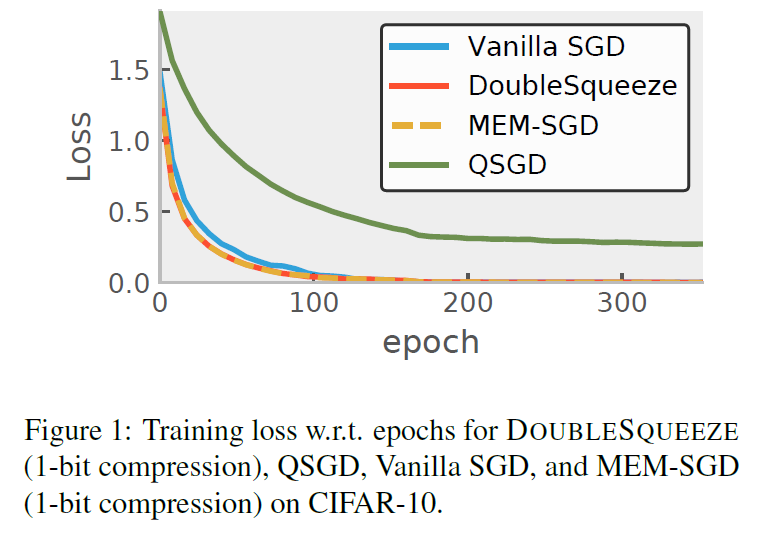
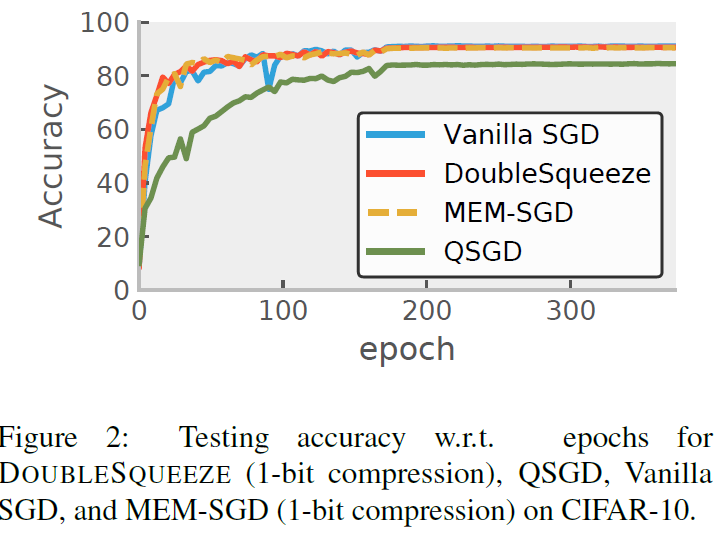
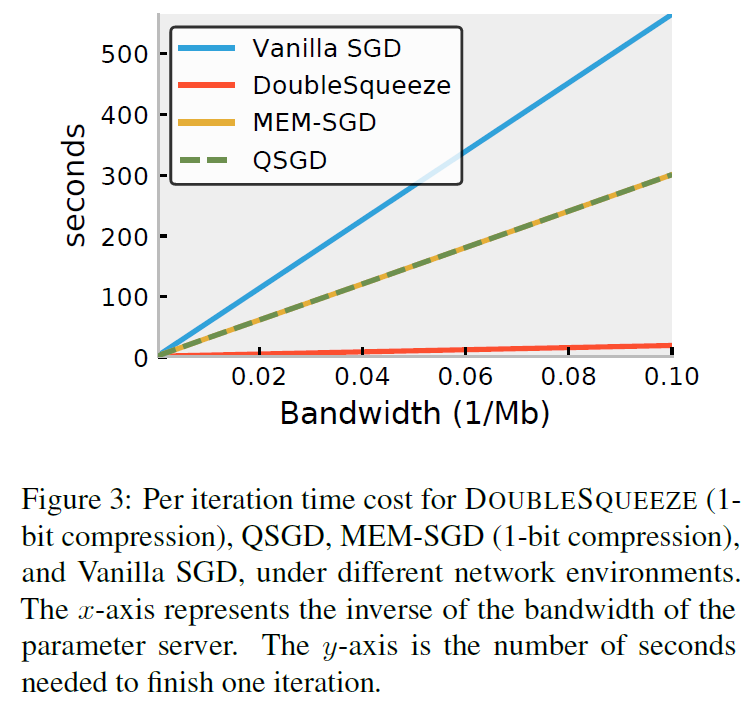
- 将Top-k压缩作为DEUBLESQUEEZE的压缩方法,与MEM-SGD, QSGD这些压缩方法做对比
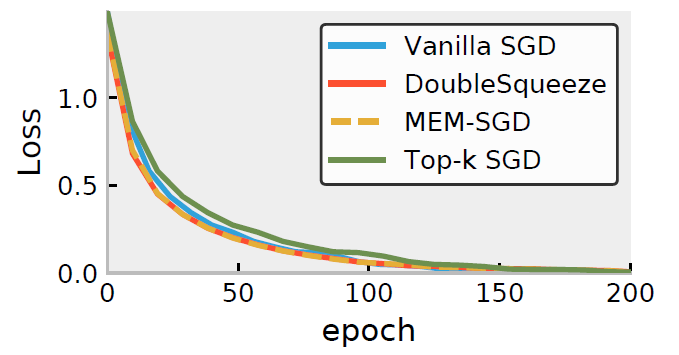
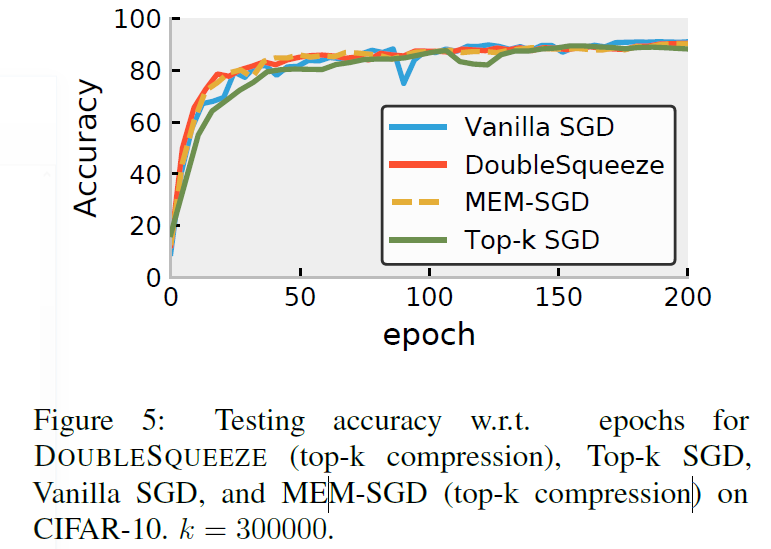
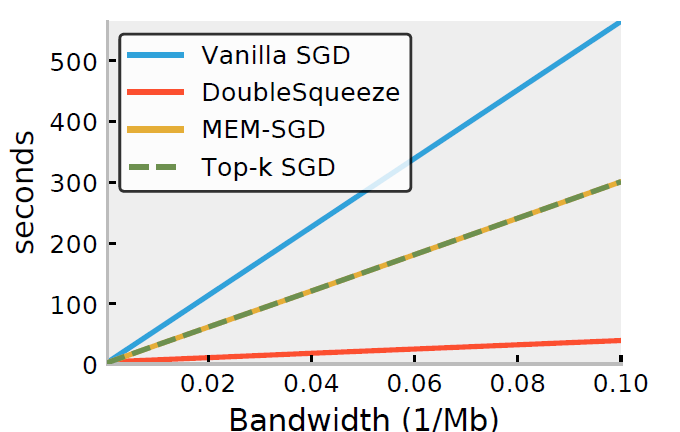
- [1] Alistarh D, Grubic D, Li J, et al. QSGD: Communication-efficient SGD via gradient quantization and encoding[C]//Advances in Neural Information Processing Systems. 2017: 1709-1720.
- [2] Bernstein J, Wang Y X, Azizzadenesheli K, et al. signSGD: Compressed Optimisation for Non-Convex Problems[C]//International Conference on Machine Learning. 2018: 560-569.
- [3] Seide F, Fu H, Droppo J, et al. 1-bit stochastic gradient descent and its application to data-parallel distributed training of speech dnns[C]//Fifteenth Annual Conference of the International Speech Communication Association. 2014.

